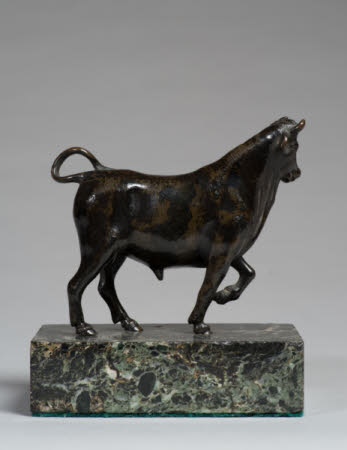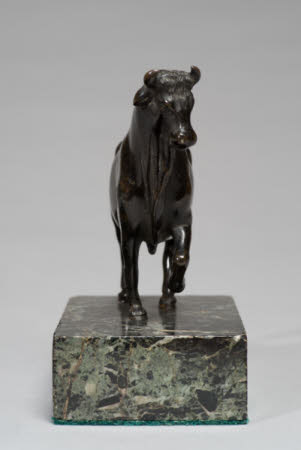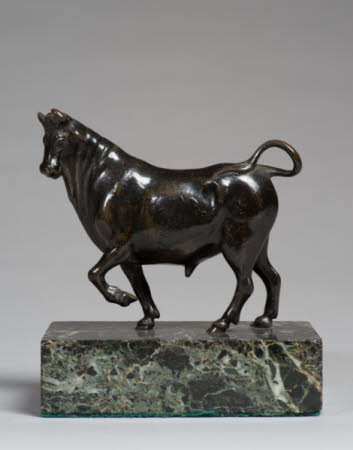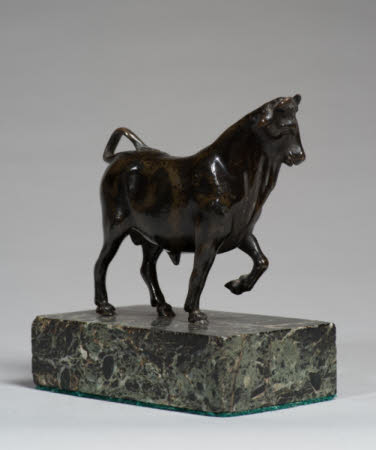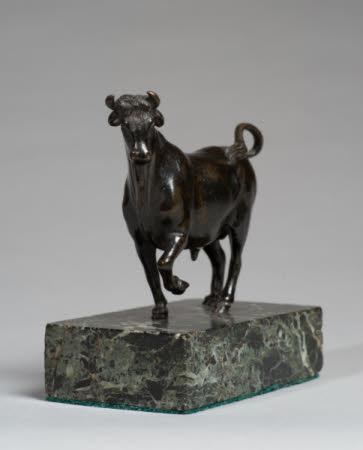A pacing bull
Italian (Florentine) School
Category
Art / Sculpture
Date
c. 1600 - 1700
Materials
Bronze
Measurements
122 mm (Height)
Place of origin
Florence
Order this imageCollection
Anglesey Abbey, Cambridgeshire
NT 515077
Summary
Bronze, a pacing bull, Italian (Florentine) School, after a model by Giambologna (Giovanni Bologna, 1529-1608) and Antonio Susini (1558-1624), c. 1600-1700. A bronze statuette of a pacing bull, after a model by Giambologna (Giovanni Bologna, 1529-1608). The animal’s head is turned slightly to its left, right foreleg raised, tail curled over onto back. Blackish lacquer patination; mounted on green variegated marble base. A small version of Giambologna’s model, a larger version of which is also at Anglesey Abbey (NT 515167).
Full description
This is a small version of a well-known model of a bull by the Italo-Flemish sculptor Giovanni Bologna (1529-1608) and his assistant and follower Antonio Susini (1568-1624). There is another version of the same model at Anglesey Abbey (NT 515167) at the more usual size of around 21 cm. high and 23 cm. long. In addition, there is also at Anglesey Abbey a pair of bronze bulls more loosely derived from Giambologna’s model (NT 515011.1 & 2). In the course of his long career as court sculptor to the Medici Grand Dukes in Florence, the Flemish-born sculptor Giambologna (Giovanni Bologna, 1529-1608) made a large number of sculptures of animals, including horses, birds and bulls. His bronze statuette of a pacing bull, based on an antique model, is first recorded as his work in 1588, in an inventory drawn up after the death in 1587 of the Grand Duke of Tuscany, Francesco de’Medici (‘Uno toro di bronzo di Giobologna di braccia 0/2 incirca’; Barocchi and Bertelà 2002, I, p. 330). However, as early as 1573 he seems to have been paid by his patron Jacopo Salviatj for a bronze bull, so the model almost certainly dates from earlier (Herbert Keutner, in Safarik 1990, p. 301). The model is recorded in a number of early collections, attesting to its popularity. One, cast and finished by Giambologna’s assistant and associate Antonio Susini, was among the bronzes after models by Giambologna presented to Prince Henry of Wales, the short-lived elder son of King James I/VI in 1611, and was later recorded in the collection of Henry’s brother King Charles I (Watson and Avery 1973, pp. 503-06, no. 7). Among the best casts of this popular model are those in the Museo Nazionale del Bargello, Florence, from the old Medici collections (inv. 287; Avery and Radcliffe 1978, no. 177) and in the Hill collection, New York (Wengraf 2014, no. 6). Both are mounted on small oval bases, characteristic of early casts that can be regarded as autograph casts modelled and finished by Giambologna himself. In both these versions, the animal has a heavier dewlap than is seen in the much more common variant type, of which the two versions at Anglesey Abbey version are examples. The variant type, slightly simpler in form and thus easier to cast in large numbers, may have been invented by Antonio Susini (for discussion of the two models, see Avery 1987, pp. 56-59, 269-70, nos. 143 & 144). An example of the normal sized variant, mounted on a cabinet in the Palazzo Colonna in Rome, was recorded in 1628 as having been made, along with a companion figure of a horse, by Antonio’s nephew Giovan Francesco Susini (Safarik 1990, pp. 300-01, nos. XV-XVI). This much smaller and quite refined version may have been created by Giambologna and Susini, in order to form a pair with a smaller model of his pacing horse, another popular animal model by Giambologna, (for an example of the horse, see NT 515096). Examples of the smaller horse and bull were in the collection of Michael Hall (Avery 1998, pp. 122-25, nos. 42-43), whilst another pair was formerly in the collection of the Duchess of Sutherland (Sculpture, Christie’s London, 7 July 1992, lot 157). The bull in Michael Hall’s collection was sold in 2010 (500 Years: Decorative Arts Europe Including Oriental Carpets and Including Sculpture from the Collection of Michael Hall, Christie’s New York, 11 June 2010, lot 80). The best examples of the small model of the bull are likely therefore to have originated in the workshops of Antonio Susini. The Anglesey Abbey example is of quite good quality, but is not by Susini himself. It is nevertheless likely to have been made in Florence in the seventeenth century, in the workshops of his successors. Examples of the smaller-sized bull are much less common than the larger model in museum collections, but they appear quite frequently on the art market. Some examples from sales in recent years include: a gilt-bronze version formerly in the collection of Eric Korner (Important European Furniture, Sculpture, Tapestries & Carpets, Christie’s London, 10 June 2004, lot 18; European Furniture, Works of Art, Tapestries and Carpets, Christie’s South Kensington, 13 September 2005, lot 498); another gilt-bronze example from Palazzo Odescalchi, Rome (Seven Centuries: Italian Works of Art From Palazzo Odescalchi, Rome, Christie’s London, 8 November 2007, lot 355); gilt-bronze, collection of P.J. Rankin (Old Master Sculpture & Works of Art, Sotheby’s London, 10 December 2015, lot 381). Jeremy Warren 2020
Provenance
Bequeathed to the National Trust by Huttleston Rogers Broughton, 1st Lord Fairhaven (1896-1966) with the house and the rest of the contents.
Credit line
Anglesey Abbey, The Fairhaven Collection (The National Trust)
Makers and roles
Italian (Florentine) School, sculptor after Giambologna (Douai 1529 - Florence 1608), sculptor Antonio Susini (fl.Florence 1572 – d.Florence 1624), sculptor
References
Barocchi and Bertelà 2002: Paola Barocchi and Giovanna Gaeta Bertelà, Collezionismo mediceo e storia artistica I, 2 vols., Florence 2002 Safarik 1990: Eduard A. Safarik, Catalogo della Galleria Colonna in Rome. Sculture, Rome 1990 Watson and Avery 1973: Katherine Watson and Charles Avery, 'Medici and Stuart: A Grand Ducal gift of "Giovanni Bologna" bronzes for Henry Prince of Wales (1612), Burlington Magazine, no. 845, vol.115, 1973, pp. 493-507. Avery and Radcliffe 1978: Charles Avery and Anthony Radcliffe, Giambologna, 1529-1608: sculptor to the Medici, exh.cat. venues: Royal Scottish Museum, Edinburgh, Victoria & Albert Museum, London, Kunsthistorisches Museum, Vienna 1978 Wengraf 2014: Patricia Wengraf (ed.), Renaissance and Baroque Bronzes from the Hill Collection, exh. cat., Frick Collection, New York 2014 Avery 1987: Charles Avery, Giambologna, The Complete Sculpture, Oxford 1987 Avery 1998: Charles Avery, Giambologna, An Exhibition of Sculpture by the Master and his followers, from the Collection of Michael Hall, Esq., exh. cat., Salander-O’Reilly Galleries, New York 1998 Christie, Manson & Woods 1971: The National Trust, Anglesey Abbey, Cambridge. Inventory: Furniture, Textiles, Porcelain, Bronzes, Sculpture and Garden Ornaments’, 1971, p. 139.

